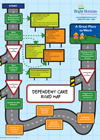In the quest for the optimized workforce, HR teams are perpetually on the lookout for the one single thing that will do it all.
The problem: the trendy "one thing" doesn't exist. How do we know? Observe some of these "next big things," as told by real HR trends headlines from roughly the last year:
Even the tightest-knit cultures can't (and shouldn't want to) get around the fact that workforces - like humans in general - are multi- dimensional. What works for one might not work for another; and it's a good bet that even the latest and greatest benefit that's beloved by some employees ("My open office is great for interoffice communication!") is going to get hammered by someone else ("Please give me back my walls!"). Those strategies become even less popular when they're foisted upon employees wholesale.
The mass office-space overhaul (and now apparently re-overhaul) makes a good cautionary tale because it was based on what employers thought they knew about employees - specifically that Millennials, as one headline put it, don't care about privacy. "Is that true?" asked the Huffington Post of one employer in the midst of a redesign. Well, replied the employer, "The answer is dependent on the personality of each millennial which makes the answer complicated."
Amen.
Speaking of Millennials, it's hard to believe, but even they didn't last as the focus of the universe.
Remember this headline? "It's official: Millennials have surpassed baby boomers to become America's largest living generation." That was so 2016.
It's recently been supplanted by this one: "Millennials Are Over. It's Gen Z's Turn To Ruin Everything."
What will they think of next?
The problem: the trendy "one thing" doesn't exist. How do we know? Observe some of these "next big things," as told by real HR trends headlines from roughly the last year:
Open Offices Foster a Sense of Community
Open offices are destroying the workplace
Loneliness is an epidemic
Solitude is a competitive advantage
Working from Home is Having a Moment
Why the Work-From-Home Trend is About to Explode
Sitting too long can kill you
Standing Now Also Killing You
Huh...how 'bout that. It's like one size doesn't fit all.HR Trends Come and Go: ROI Should Last
All of the above are examples of trying to hitch a whole workforce to the most current HR trends bandwagon; to find that one thing that will change the course. But "one thing" won't do it. At best it has a short reach; at worst it's a source of conflict.Even the tightest-knit cultures can't (and shouldn't want to) get around the fact that workforces - like humans in general - are multi- dimensional. What works for one might not work for another; and it's a good bet that even the latest and greatest benefit that's beloved by some employees ("My open office is great for interoffice communication!") is going to get hammered by someone else ("Please give me back my walls!"). Those strategies become even less popular when they're foisted upon employees wholesale.
The mass office-space overhaul (and now apparently re-overhaul) makes a good cautionary tale because it was based on what employers thought they knew about employees - specifically that Millennials, as one headline put it, don't care about privacy. "Is that true?" asked the Huffington Post of one employer in the midst of a redesign. Well, replied the employer, "The answer is dependent on the personality of each millennial which makes the answer complicated."
Amen.
Where Real Benefits ROI Comes From
And it's not just office spaces. Benefits, policies, and strategies all have to speak to multiple audiences. It's the reason employee surveys are so important (to find out what employees really need). It's the reason HR investments need to be based on those surveys (to get ROI). It's also the reason the most effective platforms don't aim at any single life stage or demographic (to avoid being exclusive to, say, Millennials).Speaking of Millennials, it's hard to believe, but even they didn't last as the focus of the universe.
Remember this headline? "It's official: Millennials have surpassed baby boomers to become America's largest living generation." That was so 2016.
It's recently been supplanted by this one: "Millennials Are Over. It's Gen Z's Turn To Ruin Everything."
What will they think of next?





